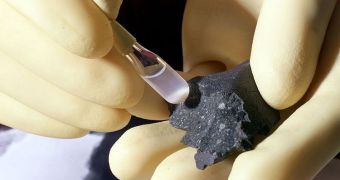Some four decades ago, a large meteorite made its way to the Earth, in one of the rare instances in which such a descent was observed. The Murchison rock has since become one of the most studied on Earth, because it is relatively large, weighing more than 100 kilograms, and also because it apparently carries millions of various organic compounds. The kick is that the rock appears to be even older than the Sun, which is currently aged at around 4.65 billion years old. A recent investigation was able to conclude that indeed the meteorite contained the wide array of compounds it was thought to, the BBC News reports.
Experts behind the study published their discoveries in the latest issue of the respected journal Proceedings of the National Academy of Sciences (PNAS). “Having this information means you can tell what was happening during the birth of the Solar System. We are really excited. When I first studied it and saw the complexity I was so amazed. Meteorites are like some kind of fossil. When you try to understand them you are looking back in time,” expert Dr. Philippe Schmitt-Kopplin, who is based at the Institute for Ecological Chemistry, in Neuherberg, Germany, says. The scientist has also been the lead researcher of the investigation.
The analysis of the chemicals on the meteorite, which struck in Murchison, Victoria, in Australia in 1969, shows clear indicators that the composition of the earliest solar system had a much higher molecular diversity than our planet does at this point. The conclusions were based on a thorough analysis of the object, which was conducted using advanced, high-resolution tools, including spectroscopy. A single sample of the meteorite allowed the researchers to accurately identify up to 14,000 different compounds in the rock, of which 70 were amino acids. These are the building blocks of proteins, which are in turn indispensable to life.
But the advanced modeling of the new data seems to indicate that the meteorite as a whole could have as much as several million organic compounds inside it. “We have to crush a few milligrams from the core of the meteorite to enable the extractions with solvents and thus we only see the extractable fraction. In addition we are only seeing the ions we can generate with the ionization source of our mass spectrometer. With different types of ionization sources we could see even more,” the team leader adds.
“I guess many people working in these fields [debating on how life on Earth appeared] with access to this knowledge will have some further hypothesis and will possibly be having some of their hypotheses confirmed. Where did we come from and what happened before? We all have that question inside us,” Dr. Schmitt-Kopplin concludes.

 14 DAY TRIAL //
14 DAY TRIAL //